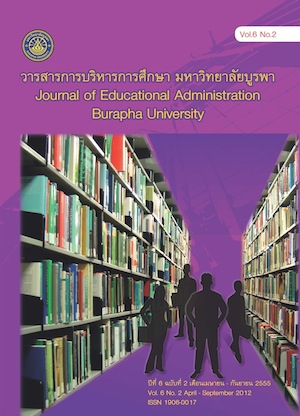รูปแบบการพัฒนาคุณภาพการศึกษาตามยุทธศาสตร์ การพัฒนาโรงเรียนขนาดเล็ก ด้วยกระบวนการวิจัย เชิงปฏิบัติการแบบมีส่วนร่วม สังกัดสำนักงาน คณะกรรมการการศึกษาขั้นพื้นฐาน DEVELOPING A MODEL FOR EFFICIENCY IN EDUCATION FOLLOWING THE STRATEGY TO DEVELOP THE SMALL SIZE SCHOOL BY PARTICIPATORY ACTION RESEARCH UNDER THE...
Keywords:
รูปแบบการพัฒนาคุณภาพการศึกษา, ยุทธศาสตร์การพัฒนาโรงเรียนขนาดเล็ก, กระบวนการวิจัยเชิงปฏิบัติการแบบมีส่วนร่วม, Developing model for efficiency in education, The strategy to develop the small size school, Participatory action researchAbstract
บทคัดย่อ
การวิจัยครั้งนี้มีวัตถุประสงค์เพื่อสร้างรูปแบบการพัฒนาคุณภาพการศึกษาตามยุทธศาสตร์การพัฒนาโรงเรียนขนาดเล็ก ด้วยกระบวนการวิจัยเชิงปฏิบัติการแบบมีส่วนร่วม สังกัดสำนักงานคณะกรรมการการศึกษาขั้นพื้นฐาน โดยใช้วงจรปฏิบัติการของเคมมิสและแม็คแทกการ์ท (Kemmis& McTaggart, 1988) กลุ่มที่เข้าร่วมปฏิบัติการวิจัย ได้แก่ ผู้อำนวยการโรงเรียน จำนวน 1 คนครู จำนวน 7 คน และคณะกรรมการสถานศึกษาขั้นพื้นฐาน จำนวน 7 คน โดยศึกษาที่โรงเรียนบ้านคลองขวางบน จังหวัดปทุมธานี การเก็บรวบรวมข้อมูล ใช้วิธีการวิเคราะห์เอกสาร แนวคิดการสัมภาษณ์เชิงลึก การสนทนากลุ่ม และการสังเกตแบบมีส่วนร่วมผลการวิจัยพบว่า รูปแบบการพัฒนาคุณภาพการศึกษาตามยุทธศาสตร์การพัฒนาโรงเรียนขนาดเล็ก ด้วยกระบวนการวิจัยเชิงปฏิบัติการแบบมีส่วนร่วม สังกัดสำนักงานคณะกรรมการการศึกษาขั้นพื้นฐาน ตาม 4 ยุทธศาสตร์หลัก คือ 1) การพัฒนาระบบวางแผนและการบริหารจัดการ 2) การพัฒนาระบบการเรียนการสอนและการประกันคุณภาพการศึกษา 3) การเสริมสร้างความพร้อมและความเข้มแข็งของโรงเรียน 4) การส่งเสริมการมีส่วนร่วมจากทุกภาคส่วนในการจัดการศึกษาโดยมีรูปแบบ คือการพัฒนาคนในด้านความชำนาญในทักษะด้านสารสนเทศ การสร้างขวัญและกำลังใจและพัฒนาโครงสร้างการทำงานที่เหมาะสม การพัฒนาระบบงานในด้านการผลิตสื่อ การใช้แผนการสอนคละชั้น การนิเทศ และการส่งเสริมให้ครูได้เข้ารับการอบรม การมีส่วนร่วมในด้านเครือข่ายชุมชนและทรัพยากร และการเสริมสร้างศักยภาพในด้านการหมุนเวียนการสอนของครู หมุนเวียนสถานที่และระบบดูแลช่วยเหลือนักเรียน จากรูปแบบที่พัฒนาขั้น จะนำไปสู่การพัฒนาคุณภาพการศึกษาตามยุทธศาสตร์การพัฒนาโรงเรียนขนาดเล็ก 4 ด้าน คือคุณภาพครู คุณภาพการบริหารจัดการ คุณภาพนักเรียน และคุณภาพการเรียนการสอนประสิทธิผลของรูปแบบทำให้โรงเรียนเกิดการพัฒนาในด้านความรู้ความสามารถของครูความเข้าใจ พัฒนาการทำงาน มีระบบการบริหารจัดการที่ดี มีการใช้ทรัพยากรทั้งภายในและภายนอกโรงเรียนอย่างมีประสิทธิภาพ และนักเรียนมีโอกาสได้เรียนรู้อย่างหลากหลายเพิ่มมากขึ้นตามศักยภาพของตนและได้เรียนรู้ อย่างมีความสุขและเกิดความรักและความผูกพันโรงเรียนมากยิ่งขึ้น
ABSTRACT
The purpose of this study was to develop model for efficiency in education followinga strategy to develop the small size school by participatory action research under theOffice of the Basic Education Commission. This study was the participatory action research (PAR) based on the action research spiral of Kemmis and McTaggart (1988). The keyparticipants of this study consisted of one administrator, seven teachers and seven stafffrom the basic education committee from Banklongquangbon School in Pathumthaniprovince. Data were collected by document analysis, in-depth interview, focus groupdiscussion, and participative observation.The study revealed that to develop the model for efficiency in education followinga strategy to develop the small size school by participatory action research under theOffice of the Basic Education Commission consisted of four main strategies : 1) Developingthe planning system and management. 2) Developing instructional system and theeducational quality assurance. 3) Enhancing the readiness and strength of the school. 4) Enhancing the coordination from all stakeholders involved in education management. The model was developed through personal information skills, good reinforcement, andthe development of appropriate working construction. Developing the working systeminvolved creating and conducting instructional materials, using multigrade classrooms,supervising and monitoring closely by the administrator and supporting teachers toattain the meeting. Enhancing coordinating involved community network and gatheringresources. And enhancing the readiness and strength of the school should employrotating teachers based on their capability and aptitude, improving buildings, andstudents’ assistant system. The model developed to help schools to develop quality ofeducation by following strategies to develop the small size school by four aspects ofquality of teachers, students, management and instructional system. The effectiveness of model could develop the school as follows: developingknowledge and abilities of teachers, the understand of working development, goodmanagement, the efficiency of internal and external resources utilization, and studentshave more opportunities to learn with full capabilities of themselves, happily learning, and more commitment to the school.

